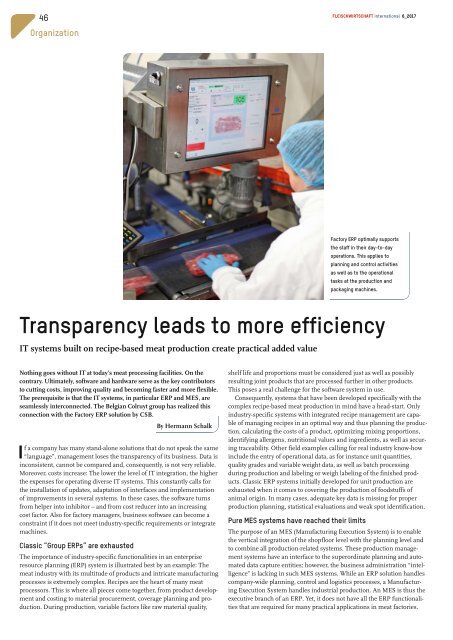FLEISCHWIRTSCHAFT international 6/2017
Create successful ePaper yourself
Turn your PDF publications into a flip-book with our unique Google optimized e-Paper software.
46<br />
Fleischwirtschaft <strong>international</strong> 6_<strong>2017</strong><br />
Organization<br />
Factory ERP optimallysupports<br />
the staff in their day-to-day<br />
operations. This applies to<br />
planning and control activities<br />
as well as to the operational<br />
tasks at the production and<br />
packaging machines.<br />
Transparency leads to more efficiency<br />
IT systems built on recipe-based meat production create practical added value<br />
Nothing goes without IT at today’s meat processing facilities. On the<br />
contrary.Ultimately,software and hardware serve as the key contributors<br />
to cutting costs, improving quality and becoming faster and more flexible.<br />
The prerequisite is that the IT systems, in particular ERP and MES, are<br />
seamlessly interconnected. The Belgian Colruyt group has realized this<br />
connection with the Factory ERP solution by CSB.<br />
By HermannSchalk<br />
Ifacompany has many stand-alone solutions that do not speak the same<br />
“language”, management loses the transparency of its business. Data is<br />
inconsistent, cannot be compared and, consequently,isnot very reliable.<br />
Moreover,costs increase: The lower the level of IT integration, the higher<br />
the expenses for operating diverse IT systems. This constantly calls for<br />
the installation of updates, adaptation of interfaces and implementation<br />
of improvements in several systems. In these cases, the software turns<br />
from helper into inhibitor –and from cost reducer into an increasing<br />
cost factor.Also for factory managers, business software can become a<br />
constraint if it does not meet industry-specific requirements or integrate<br />
machines.<br />
Classic “Group ERPs” are exhausted<br />
The importance of industry-specific functionalities in an enterprise<br />
resource planning (ERP) system is illustrated best by an example: The<br />
meat industry with its multitude of products and intricate manufacturing<br />
processes is extremely complex. Recipes are the heart of many meat<br />
processors. This is where all pieces come together,from product development<br />
and costing to material procurement, coverage planning and production.<br />
During production, variable factors like raw material quality,<br />
shelf life and proportions must be considered just as well as possibly<br />
resulting joint products that are processed further in other products.<br />
This poses areal challenge for the software system in use.<br />
Consequently,systems that have been developed specifically with the<br />
complex recipe-based meat production in mind have ahead-start. Only<br />
industry-specific systems with integrated recipe management are capable<br />
of managing recipes in an optimal way and thus planning the production,<br />
calculating the costs of aproduct, optimizing mixing proportions,<br />
identifying allergens, nutritional values and ingredients, as well as securing<br />
traceability.Other field examples calling for real industry know-how<br />
include the entry of operational data, as for instance unit quantities,<br />
quality grades and variable weight data, as well as batch processing<br />
during production and labeling or weigh labeling of the finished products.<br />
Classic ERP systems initially developed for unit production are<br />
exhausted when it comes to covering the production of foodstuffs of<br />
animal origin. In many cases, adequate key data is missing for proper<br />
production planning, statistical evaluations and weak spot identification.<br />
Pure MES systems have reached their limits<br />
The purpose of an MES (Manufacturing Execution System) is to enable<br />
the vertical integration of the shopfloor level with the planning level and<br />
to combine all production-related systems. These production management<br />
systems have an interface to the superordinate planning and automated<br />
data capture entities; however,the business administration “intelligence”islacking<br />
in such MES systems. While an ERP solution handles<br />
company-wide planning, control and logistics processes, aManufacturing<br />
Execution System handles industrial production. An MES is thus the<br />
executive branch of an ERP. Yet, it does not have all the ERP functionalities<br />
that are required for many practical applications in meat factories.

















